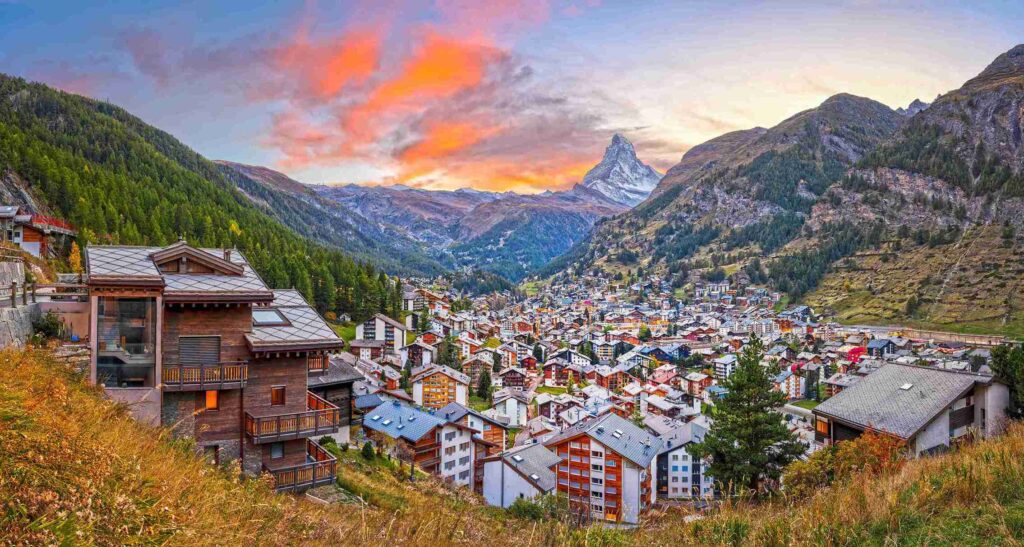Zermatt, Switzerland – Travel Tips
Category
Categories
Popular Articles

**Overview of the Destination**
Nestled in the heart of the Swiss Alps, Zermatt is a charming mountain resort that is renowned for its world-class skiing, climbing, and hiking. The village is most notably known for the iconic Matterhorn that majestically looms over it. Filled with traditional chalets, rambunctious apres-ski bars, and some of the most scenic landscapes in Switzerland, Zermatt is the perfect winter wonderland that’s worth visiting.
**Best Time to Visit**
The best time to visit Zermatt depends on what you have on your itinerary. For skiing and wintertime activities, the prime months are from late November to early April. Meanwhile, for hiking, Mountaineering, and other summer activities, June to mid-October provides perfect conditions. The month of August hosts the Folklore Festival, a traditional Swiss celebration that brings vibrantly colored costumes, traditional Swiss music, and hearty local dishes.
**Climate & What to Pack**
Zermatt enjoys a mild alpine climate. Winters can be chilly with temperatures ranging between -8 to 3 degrees Celsius. So, be sure to pack warm layers, hats, gloves, scarves, and sturdy shoes. Summers in Zermatt are comfortably warm but with sudden rain showers, temperatures vary from 12 to 25 degrees Celsius. Light layers, a rain jacket, and hiking boots are recommended.
**Getting There**
The nearest major airport to Zermatt is Geneva Airport (GVA). From the airport, you can take a train to Zermatt which takes approximately 3 hours. Be aware that Zermatt is a car-free zone, so plan your transport accordingly. For non-EU citizens, a Schengen visa might be required.
**Getting Around Locally**
Zermatt is pedestrian-friendly with electric taxis available for local transport. You can also rent a bike to explore the stunning countryside. Considering it’s a car-free village, walking or utilizing the numerous mountain cable cars is the best way to get around.
**Safety Tips**
Zermatt is generally a safe destination, however, always keep an eye out for your belongings particularly in crowded areas. As Zermatt is a snowy region, be aware of slippery roads and paths. Always check weather conditions before embarking on hikes or climbs.
**Top Things to Do & See**
Zermatt’s standout attraction is, of course, the Matterhorn. Whether you’re skiing its slopes, taking a cable car ride, or admiring it from the village, it’s an unmissable feature. Other must-see spots include Gornergrat railway, a cogwheel train that offers breathtaking views, the Glacier Paradise, and a visit to the Matterhorn Museum.
**Where to Stay**
In Zermatt, accommodations can range from luxury hotels like the Zermatterhof and Omnia to budget-friendly options such as Hotel Rhodania or Hotel Tschugge. The best areas to stay, for easy access to main attractions and restaurants, are around Bahnhofstrasse Street and Schluhmattstrasse.
**Food & Local Cuisine**
Do not miss out on trying raclette, fondue, and rösti, traditional Swiss dishes that you’ll find in almost every restaurant. For restaurants, Chez Vrony and Zum See are particularly popular. Don’t forget to try Swiss chocolate and cheese.
**Cultural & Practical Tips**
The currency is Swiss Franc (CHF). Though, credit cards are widely acceptable. The official language is German, but English is commonly spoken in the tourist areas. Tipping isn’t mandatory as it’s generally included in the bill. Wi-Fi is widely available. Swiss plugs are type J with the standard voltage being 230 V.
**Sustainable or Responsible Travel Tips**
Remember to leave no trace when enjoying outdoor activities. Recycle as much as possible and respect local customs and traditions.
As I end this guide, my personal insight would be to take your time in Zermatt. From hiking in the Alpine meadows to relaxing in the village’s tranquillity, Zermatt deserves to be savored. Don’t just rush to tick off the major attractions – enjoy the journey as well.










